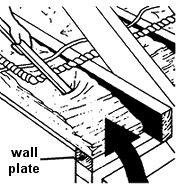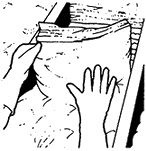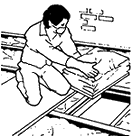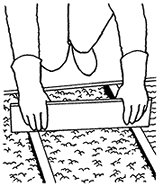Loft Insulation
loft insulation materials - before you start - estimating insulation materials - safety - installing roll insulation - loose fill installation
In most cases the addition of loft insulation is within the capability of the do-it-yourself householder. Follow the manufacturer's instructions for the insulation material being used.
Most loft insulation materials work by preventing the movement of heated air through the material.
The fibres of matting insulation trap air within it, for the matting to be effective, the weave should not be over stretched or compressed as the structure trapping the air may be destroyed.
Loose fill insulation materials like vermiculite are very poor conductors of heat and, being small, form a near impervious thermal barrier.
Loft Insulating Materials
 Mineral
fibre or fibreglass matting is usually available in rolls 400mm (16in) wide. Thicknesses range from 100mm (4 in) to 200mm (8 in). In the UK, the total thickness of insulation should be at least 200mm (8in), the thinner insulation material available allow for old, thinner loft insulation to be overlaid to achieve the 200mm.
Mineral
fibre or fibreglass matting is usually available in rolls 400mm (16in) wide. Thicknesses range from 100mm (4 in) to 200mm (8 in). In the UK, the total thickness of insulation should be at least 200mm (8in), the thinner insulation material available allow for old, thinner loft insulation to be overlaid to achieve the 200mm.
Roll insulation can be installed by most diy'ers.
Loose-fill loft insulation materials which are blown into the loft are usually mineral wool or cellulose fibres, installation is a specialist job which should be left to a contractor.
The materials generally have the same insulation value as rolls of loft insulation and should have a minimum finished thickness of 200mm (8in) - most roof joists are only 100 to 150mm (4 to 6 in) so some means of increasing the depth of joist may be necessary.
 DIY loose-fill loft insulation materials, such as vermiculite and mineral fibre, are sold in bags and can be poured between the joists to the recommended depth. They are easier to install than the matting if there are awkward corners or obstructions in the loft space. They also make the job easier if the joist spacings are irregular or not suitable for a standard width of matting. Again, the depth of the joists may need to be increased so that the required depth of cover is achieved.
DIY loose-fill loft insulation materials, such as vermiculite and mineral fibre, are sold in bags and can be poured between the joists to the recommended depth. They are easier to install than the matting if there are awkward corners or obstructions in the loft space. They also make the job easier if the joist spacings are irregular or not suitable for a standard width of matting. Again, the depth of the joists may need to be increased so that the required depth of cover is achieved.
Before starting work in the loft
- If there is no way into the loft, make a permanent hatchway.
- If a stepladder is being used to gain access to the loft, tie the ladder firmly in place or have someone holding it while it is being used.
- Do not try to work standing on the joists, use a piece of board reaching across three joists so that it is stable to kneel safely upon.
The ceiling of the rooms below between the joists will not carry a persons weight. - Do not try to install loft insulation using only a torch to light the area, if there is no lighting installed in the loft, run an extension lead up into the void and hang a suitable light from a beam.
- Make sure that the depth of the ceiling joists is adequate if using loose fill material. The height of the joists can be increased by nailing strips of wood to the top of the joists, but it might be simpler to use an alternative insulating material which would not need to be as thick to achieve the recommended level of loft insulation,
- Check that the roof void is adequately ventilation to avoid condensation. If there is daylight at the eaves or if the tiles and slates are visible in the roof space, ventilation is probably adequate. But if the roof is boarded or felted under the tiles (so that you can not see them), and there is no obvious ventilation at the eaves, additional ventilation should be added.
A roof void needs ventilation equivalent to the area of a continuous 10mm (3/8 in) slot at eaves level. Where the eaves has a soffit, installing soffit vents can increase ventilation.
If there will only be a small space between the roof and insulation at the eaves, small ventilation strips can be added between the roof trusses to ensure that the insulation is kept away from the roof. - Joist end boards need to be fitted if loose fill insulation is to be installed; these will keep the insulation in the loft rather than falling out down the cavity or into the eaves.
- Cracks and holes in the ceiling should always be filled before laying the insulation. They can allow heated air to reach the loft, which can lead to condensation problems. And if you are using loose fills, they may allow it to fall down.
- When adding loft insulation it is essential to insulate any water tank and/or pipework in the void - do not insulate under the tank.
- Before insulation is installed, check the loft for possible problems which might require attention - particularly electric wiring, insect infestation and the state of the roof covering - corrective action will be easier without the insulation installed. The cables and roof structure should be checked by competent persons to identify if corrective action is necessary.
- Electric wiring should not be covered by the loft insulation. If cables are covered by insulation, the small amount of heat generated by the cable will not be dissipated and the cables could become hot and possibly cause a fire.
Estimating loft insulation materials
Roll material
Measure the distance between the ceiling joists - it will, hopefully, be the same as the width of the roll or up to 50mm (2 in) under the width. If the distance between the joists is larger than the roll width, it will be necessary to consider how the gap will be filled.
Measure the length of the joists across the roof, count the number of joist spaces and work out the total length of insulation required and then how many insulation rolls are needed.
Loose-fill material.
Simply measure the floor area of the loft in square metres - about 200 litres of the material is required to achieve a 200mm (8 in) coverage per square metre.
Safety
Mineral wool insulation can irritate the skin and throat and should be installed with care.
- Wear a suitable dust mask to avoid throat irritation and protective gloves to prevent irritation to the hands.
- The loft space can become very hot even on an overcast day, but always wear long sleeved/legged clothing or an overall to protect your skin. Tuck the shirt sleeves and trouser legs into the gloves and socks respectively.
- Only open the package of insulation in the loft.
- Unroll or pour out the material gently so that loose fibres do not become air borne.
- Keep the hatch closed while working.
- Bag-up any waste in the loft, before moving it through the house.
- Throw away the dust mask after use and wash overalls, gloves and other clothing separately from the normally weekly wash.
Laying mineral/glass fibre roll insulation
- Clean the space between the joists to remove dust and any debris left by the builders.
- Seal any cracks in the ceiling and gaps around pipes/cables etc. where they go through the ceiling. It is easiest to do this from above; push pieces of newspaper into any large gaps and cover with an interior type decorating filler.
- Fit any ventilation panels in between the roof trusses if necessary. Screw a couple of wooden blocks between adjacent trusses, and fit a thin piece of plywood (or similar) to give a air gap between the back of the plywood and the inside of the roofing.
 Starting at the eaves, unroll the insulating material between the joists, rolling it towards the centre of the loft. Push the insulation (without stretching it) along the ceiling until it covers the top of the inner wall plate, but make sure a gap is left at the eaves for ventilation.
Starting at the eaves, unroll the insulating material between the joists, rolling it towards the centre of the loft. Push the insulation (without stretching it) along the ceiling until it covers the top of the inner wall plate, but make sure a gap is left at the eaves for ventilation. - Feed the insulation under electric cables, being careful not to stretch or damage the cables.
- Also feed the insulation under any roof members going across the joists.
- At the centre of the loft (or other suitable point), cut the roll using scissors (do not tear) and push the edges down against the joists.
- Do not insulate under any cold water tank in the loft, the tank must be insulated separately.
- Where there are pipes or wiring going down the side of the joists, the insulation can normally just be pushed into place around them.
- Where pipes or cables are away from the joists, just cut the matting to allow it to fit around them. Where parts of the roof structure reduce the space between joists, cut the matting so that it fits around the obstruction.
- If water pipes runs along between the joists such that roll insulation cannot be fed underneath or over it, the matting may need to be cut lengthways so that separate pieces can be fitted along each side of the pipes. Alternatively, it is often easier to fill these awkward areas using loose fill insulation.
 With
the first piece of insulation laid, move to the opposite side of loft and roll the insulation towards the previous length. Cut
and butt the ends closely together where the lengths meet in the middle.
With
the first piece of insulation laid, move to the opposite side of loft and roll the insulation towards the previous length. Cut
and butt the ends closely together where the lengths meet in the middle.
Repeat along the remaining joist spaces until the whole loft area is covered.
 Fix a piece of insulating material to the top of the loft hatch cover. Wrap a suitable piece of insulation in polythene to make it easier to handle. Make sure that the hatch cover fits properly, and draught-proof its edges with a good quality draught-strip.
Fix a piece of insulating material to the top of the loft hatch cover. Wrap a suitable piece of insulation in polythene to make it easier to handle. Make sure that the hatch cover fits properly, and draught-proof its edges with a good quality draught-strip.
Laying loose fill loft insulation
- Clean the space between the joists to remove dust and any debris left by the builders.
- Seal any cracks in the ceiling and gaps around pipes/cables where they go through the ceiling. It is easiest to do this from above, push pieces of newspaper into any large gaps and cover with an interior type decorating filler.
- Before starting to pour the insulation, the gaps between the joists must be sealed under the eaves to keep the insulation in the loft space.
Proprietary products for retaining the insulation at the eaves are available from some building merchants or alternatively a simple board can be screwed between each pair of joists. Screw a couple of wooden blocks between adjacent joists, and fit a thin piece of plywood (or similar). Ensure that adequate ventilation is achieved at the eaves whichever method is used.  Loose-fill insulation is simply poured between the joists to the required depth. If the depth of fill does not exceed the depth of the joists, using a piece of board cut to size can level it.
Loose-fill insulation is simply poured between the joists to the required depth. If the depth of fill does not exceed the depth of the joists, using a piece of board cut to size can level it.
Most ceiling joists are only 100 to 150mm (4 to 6in) deep, so filling level with the top will not give adequate insulation - the top of the joist must be raised, the insulation must not just be spread across the top of the joist to achieve the required depth.
- To reach into under the eaves, a broom-handle with a wooden 'paddle' fixed to one end may make the job easier.
- Keep electric cables above the material.
- Do not insulate under water tanks in the loft, block off the joist space around the tank so that the loose fill is held away.
- Where water pipes run along the joist space, use a gloved hand to work the loose fill under, between and over the pipes.
- Fix a piece of insulating material to the top of the loft hatch cover. Loose fill is not really suitable, so try to use a piece of mineral fibre, wrapped in a suitable piece of polythene to make it easier to handle. If loose fill has to be used, pack some in a suitably sized plastic bag so that it can be fixed to the hatch cover while retaining the fill. Make sure that the hatch cover fits properly, and draught-proof its edges with a good quality draught-strip. It may need a catch or bolt to keep it tightly shut against the draught strips.
- After installation, keep a watch on the loose fill material in excessively windy conditions, loose fill material can be blown around within the roof void.
loft insulation materials - before you start
- estimating insulation materials - safety
installing roll insulation - loose fill installation
